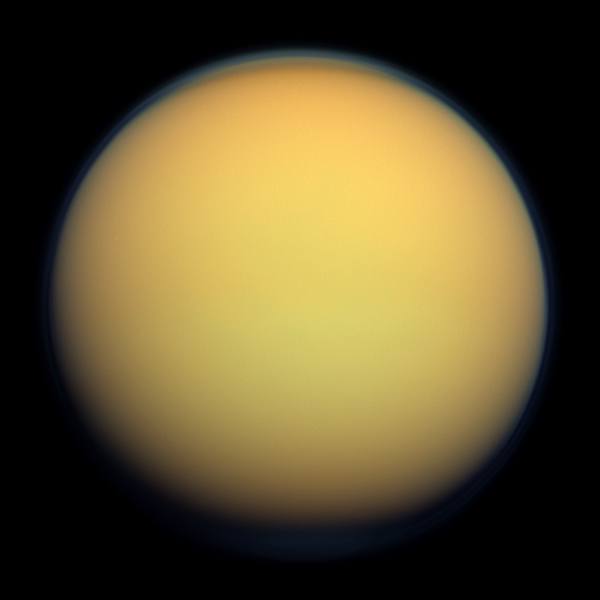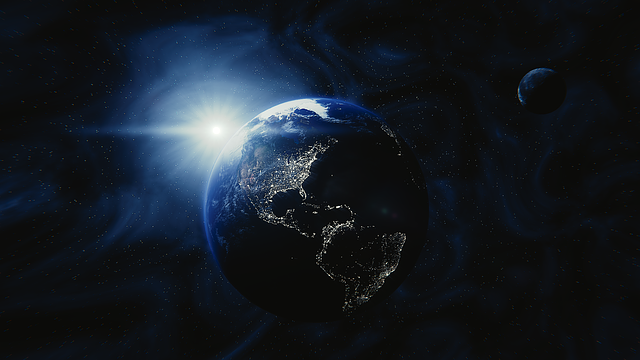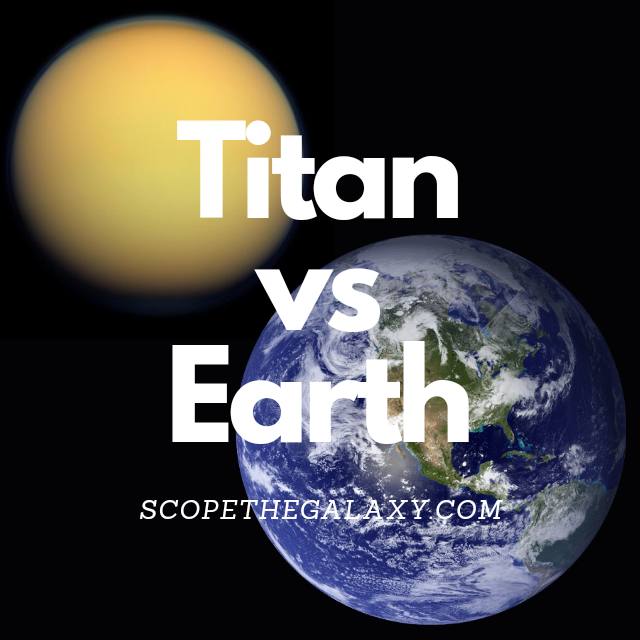*This post may contain affiliate links. This means we may make a commission if you purchase an item using one of our links*
The main differences between Titan and Earth is that Titan is a natural satellite that orbits Saturn and is the 2nd biggest moon in the solar system and is even larger than Mercury with a diameter of 5,150km whilst Earth allows intelligent life to flourish, is 12,742km in diameter and has its own natural satellite that orbits it in the Moon.
There are numerous other differences Earth and Titan have so continue reading if you want a more thorough breakdown of what they below.
What Is The Moon Titan?
Table of Contents

Titan is Saturn’s largest moon and the second biggest moon in the entire solar system, with a diameter of 5,150km. This would make it even larger than the planet Mercury which is only 4,879km, and significantly larger than Pluto also.
As a result, Titan’s gravitational strength stands at around 1.352 m/s²
It is the only natural satellite in our solar system that is composed similarly to Earth, where it has a thick atmosphere made primarily of nitrogen (95%) along with smaller amounts of methane (5%). It has rivers and lakes on its surface along with a water cycle very similar to that of Earth, where essentially water evaporates and eventually lands on the satellites surface.
Therefore, much like Earth, Titan has a terrestrial based body but, there is a difference in their atmospheric pressure. The pressure on Titan’s surface is around 60% greater than that of Earth’s surface but, it isn’t nearly as dense.
Nevertheless, it is still far denser than most other bodies at 1.88 g/cm³. As a result, Titan’s mass is 1.345×10^23 kg.
In regards to its temperature, Titan is on the colder side where it averages around -179 degrees Celsius whilst its core’s temperature is actually very cold in comparison to other entities falling between 226 – 526 degrees Celsius.
As Saturn is the 6th farthest planet from the Sun, it will take Titan roughly the same amount of time to orbit the Sun, which would fall around 29.4 years.
It takes Titan 15 days and 22 hours to orbit Saturn. A day is 15 days and 22 hours also as it is tidally locked to the gas giant.
What Is The Planet Earth?

Our home planet Earth is the 3rd farthest planet from the Sun, made up of a mixture of water and solid rock like objects, and is the only entity in our solar system known to allow intelligent life forms like ourselves to exist.
Earth’s distance of 152 million km from the Sun has allowed it to remain within the goldilocks zone and as a result, the planet has been able to thrive for millions of years. It orbits the Sun in a circular pattern, much like all the other planets, has only one natural satellite which would be the Moon and is a terrestrial planet to boot.
In regards to its diameter, Earth is the 5th largest planet with a diameter 12,742km.
Earth’s temperature ranges based on the region you’re located where it can be from as low as -94 degrees Celsius in Antarctica to as high as 50 – 55 degrees Celsius in Tunisia.
As for the planets composition, it consists of the crust, the mantle, the outer core and the inner core, where the inner core is the hottest element within the Earth reaching temperature in excess of 5,200 degrees Celsius.
In regards to some of its most unique features, Earth is around 71% water, has an atmosphere consisting mostly of oxygen and nitrogen that is also made up of 5 main layers, with the highest to lowest being the troposphere, stratosphere, mesosphere, thermosphere and exosphere.
A day on Earth is 24 hours and an orbital cycle around the Sun takes 365 days to complete. It’s axial tilt is more distinct at 23.5 degrees to the right.
How Are Earth And Titan Similar?
Titan and Earth have far more similarities than you most entities in our solar system, particularly in regards to how they function.
These similarities would include the following:
- Both have a hotter central core.
- Both have an atmosphere and a rocky surface.
- Both are a spherical shape.
- Neither are tidally locked to the Sun.
- Both have no rings surrounding them.
- Both have a very similar water cycle along with rivers and lakes.
Differences Between Titan And Earth
In regards to the differences between the two, they include the following:
- Titan is smaller than Earth with a diameter of 5,150km whereas Earth has a diameter of 12,724km.
- Titan has 0 natural satellites orbiting it whilst Earth has 1.
- Earth is the 3rd farthest planet from the Sun whilst Titan is joint 6 with Saturn and its other moons.
- It takes Earth 365 days to orbit the Sun whilst Titan takes roughly 29.4 years.
- Earth completes a day in 24 hours whilst a day on Titan takes 15 days and 22 hours.
- Earth orbits the Sun in a circular pattern 6 whilst Titan orbits Saturn elliptically.
- Titan’s atmosphere is 95% nitrogen and 5% methane whilst Earth’s atmosphere is 78.09% nitrogen, 20.95% oxygen and 0.93% argon.
- Titan’s axial tilt is 27 degrees whilst Earth’s axial tilt is 23.4 degrees.
- Earth’s gravity is 9.807 m/s² whilst Titan’s gravitational strength is 1.352 m/s².
- Titan’s density is 1.88 g/cm³ whilst Earth far more dense at 5.51 g/cm³.
- Earth is warmer on average, hitting temperatures of around 13.9 degrees Celsius whilst Titan averages around -179 degrees Celsius.
- In regards to their core temperatures, Earth’s is much hotter at 5,200 degrees Celsius compared to Titan’s far cooler 226 – 526 degrees Celsius.
- Titan is tidally locked to Saturn whilst Earth is not tidally locked to any other celestial body.
Summary
Earth and Titan are very similar when it comes how their eco systems and water cycles function but differ significantly when it comes to what they orbit, their temperature, size, gravitational strength and beyond.
Titan is amongst the mostly likely candidates to potentially support life due to the similarities it shares with Earth however, as a whole they aren’t all that close in their overall ability to potentially allow life to thrive, at least not till the human race becomes more evolved in their methods to terraform celestial bodies like Titan in order to make them habitable.


